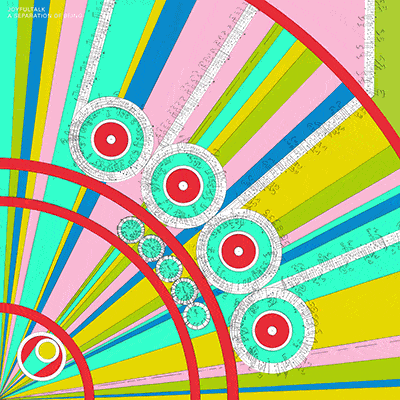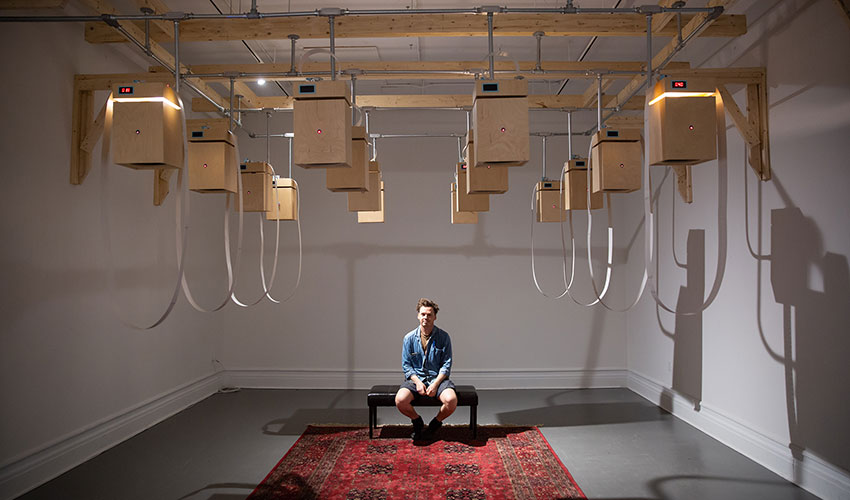Interview by Meritxell Rosell


Many composers have wrestled with the idea of how to represent their music and compositions outside the traditional linear notation. In the 20th century, some began using a radical graphical approach to writing scores, by representing music through the use of visual symbols. Graphic notation was originally used by avant-garde musicians and kicked off in the 1950s, as an evolution of the indeterminacy movement pioneered by John Cage. In many cases, these graphic scores are closer to a piece of art, using abstract symbols, images and text to convey meaning to the performers.
Circles and spherical or elliptical forms are frequently found in graphic scores representational systems. This is not surprising as these geometrical forms have intimately been related to music. In particular to the celestials and planetary order and their orbits; Pythagoras and Kepler sought harmonic proportions in the Solar System and its mathematics in what is called the music of the spheres. Think as well of Coltrane’s Circle, which takes on the circle of Fifth (a geometrical representation of relationships among the twelve pitch classes of the chromatic scale in pitch class space), attempting a spiritual journey through music using geometric principles resembling the ones that motivated Einstein’s quantum theory.
Jay Crocker (aka JOYFULTALK), a composer, improv musician and visual artist who has been developing his own graphic score system and his particular methodology for visualized composition, The Planetary Music System, since 2012. The score for A Separation Of Being, his third album under his JOYFULTALK alias, is the culmination of this system to date. The visual representation (a 5’x10’ mural which was acquired by Nova Scotia’s provincial Art Bank in 2019), features geometric multi-directional cycles of brightly-coloured, finely-detailed sound notation.
But Crocker has been making music in its diverse forms for over 2 decades, as multi-instrumentalist, arranger, producer and recording engineer. He released his debut album under the name of JOYFULKTALK in 2016. MUUIXX was an experimental album and exploration of unconventional sounds. With his second album, Plurality Trip, was a collaboration with musician Shawn Dicey, which brought an analogue electronic blend that flowed over genre boundaries.
Crocker as well has been designing and developing a particular type of analogue “clockworks”. BIBELOT is a kinetic audio installation showcasing a set of 16 handmade wooden speaker boxes suspended in a cubic array, each one on a timer and fitted with one of the various mechanical devices that trigger a sound loop: an automatic orchestra of intention and accident where the compositional experience is set in motion by randomized clockworks and only truly completed each time a viewer/listener navigates the three-dimensional space.
His album, A Separation of Being, is the most recent release, with three tracks that expand over 30 minutes, with string samples were recorded by Jesse Zubot. The album title takes a whole new dimension during these days, where we have been forced into a separation of existence. But the music doesn’t feel as division. It moves in a kind of dynamic minimalism proposed by circadian flows with Croker’s peculiar instrumentation. With A separation of being Crocker brings about the perfect example of modern graphic notation, bringing all these ideas of openness, interpretation, improv and fluidity that challenge the more linear and rigid traditional notation; and rounding cultivation of a career dedicated to musical experimentation.

You are an avant-improv musician and instrument maker but also exploring ambient/mantric compositions with your project JOYFULTALK. How and when does the interest in these compositions come about?
I am continuously writing, creating and experimenting in all aspects of my practice. Ultimately my practice is fuelled by the urge to constantly change my process to bring into focus the most immediate and present version of my creative self.
Your new album, A separation of being is based on Planetary music system, a music compositional system based on gear sets. It is an elliptical system in which the music intersects based on circular circumferences of varying ratio. What was the main inspiration for its inception and the intellectual process behind it?
The planetary music system was the writing process I used to create the new record “a Separation Of Being”. The process was created to try and find some way of scoring a piece of music that sounds like constant change while maintaining a fundamental feeling of consistency or identity. Similar to the living music that surrounds us at all times, we just have to tap in and listen to it.
What were the biggest challenges you faced for its development?
I think the main challenge was probably doing the math to figure out the ratios to bring the score from a sketch to a template in which I could input the music.
The album is based in the elliptical/circular form. What is it your personal relationship with this shape?
As corny as it sounds, I think we all Have a relationship with cycles or loops with a temporary crossover with other cycles or loops. I don’t necessarily believe that all cycles are circular are elliptical, that was just the first shape I chose to work with when doing these initial pieces using the planetary system. I have started working with other shapes and designs for new pieces.
You are also an artist and have designed the album cover, how you translated the music concepts to the artwork?
In the case of the planetary system, the process is kind of in reverse. The sketch for the piece is drawn, then I enlarge it and refine it to a bigger scale. When the drawing is complete then the music gets added to the drawing. This gives each voice a limited amount of quarter notes in which to derive its phrases within its loop. The structure and shape of the drawing completely inform the music.
Your JOYFULTAK project started when you moved from Calgary to live in a remote part of Nova Scotia’s shores surrounded by trees and nature. How does being away from the big metropolis that has impacted your practice?
Having the space and isolation of country living has allowed me to dive deeper into my mind for a more focused version of myself. But I think the other more regular challenges of having to solve problems with limited resources has been what has influenced me the most.
Where do you see taking your work into or what would you like to be exploring?
I am pretty into the servo and stepper motors right now. I want to make a sort of new-wave robot place of worship…..funny shit!!!!
What is your chief enemy of creativity?
I guess the most obvious answer is money but I try not to think of anything as an enemy to my creative process. Obstacles are the lifeblood of creativity.
You couldn’t live without…
Firewood.






